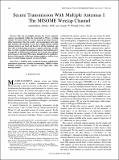| dc.contributor.author | Khisti, Ashish | |
| dc.contributor.author | Wornell, Gregory W. | |
| dc.date.accessioned | 2012-06-28T13:08:43Z | |
| dc.date.available | 2012-06-28T13:08:43Z | |
| dc.date.issued | 2010-11 | |
| dc.date.submitted | 2008-08 | |
| dc.identifier.issn | 0018-9448 | |
| dc.identifier.issn | 1557-9654 | |
| dc.identifier.uri | http://hdl.handle.net/1721.1/71245 | |
| dc.description.abstract | The capacity of the Gaussian wiretap channel model is analyzed when there are multiple antennas at the sender, intended receiver and eavesdropper. The associated channel matrices are fixed and known to all the terminals. A computable characterization of the secrecy capacity is established as the saddle point solution to a minimax problem. The converse is based on a Sato-type argument used in other broadcast settings, and the coding theorem is based on Gaussian wiretap codebooks. At high signal-to-noise ratio (SNR), the secrecy capacity is shown to be attained by simultaneously diagonalizing the channel matrices via the generalized singular value decomposition, and independently coding across the resulting parallel channels. The associated capacity is expressed in terms of the corresponding generalized singular values. It is shown that a semi-blind "masked" multi-input multi-output (MIMO) transmission strategy that sends information along directions in which there is gain to the intended receiver, and synthetic noise along directions in which there is not, can be arbitrarily far from capacity in this regime. Necessary and sufficient conditions for the secrecy capacity to be zero are provided, which simplify in the limit of many antennas when the entries of the channel matrices are independent and identically distributed. The resulting scaling laws establish that to prevent secure communication, the eavesdropper needs three times as many antennas as the sender and intended receiver have jointly, and that the optimum division of antennas between sender and intended receiver is in the ratio of 2:1. | en_US |
| dc.description.sponsorship | National Science Foundation (U.S.) (grant CCF-051510) | en_US |
| dc.language.iso | en_US | |
| dc.publisher | Institute of Electrical and Electronics Engineers | en_US |
| dc.relation.isversionof | http://dx.doi.org/10.1109/TIT.2010.2068852 | en_US |
| dc.rights | Article is made available in accordance with the publisher's policy and may be subject to US copyright law. Please refer to the publisher's site for terms of use. | en_US |
| dc.source | IEEE | en_US |
| dc.title | Secure Transmission With Multiple Antennas—Part II: The MIMOME Wiretap Channel | en_US |
| dc.type | Article | en_US |
| dc.identifier.citation | Khisti, Ashish, and Gregory W. Wornell. “Secure Transmission With Multiple Antennas-Part II: The MIMOME Wiretap Channel.” IEEE Transactions on Information Theory 56.11 (2010): 5515–5532. © Copyright 2010 IEEE | en_US |
| dc.contributor.department | Massachusetts Institute of Technology. Department of Electrical Engineering and Computer Science | en_US |
| dc.contributor.approver | Wornell, Gregory W. | |
| dc.contributor.mitauthor | Wornell, Gregory W. | |
| dc.contributor.mitauthor | Khisti, Ashish | |
| dc.relation.journal | IEEE Transactions on Information Theory | en_US |
| dc.eprint.version | Final published version | en_US |
| dc.type.uri | http://purl.org/eprint/type/JournalArticle | en_US |
| eprint.status | http://purl.org/eprint/status/PeerReviewed | en_US |
| dspace.orderedauthors | Khisti, Ashish; Wornell, Gregory W. | en |
| dc.identifier.orcid | https://orcid.org/0000-0001-9166-4758 | |
| mit.license | PUBLISHER_POLICY | en_US |
| mit.metadata.status | Complete | |
